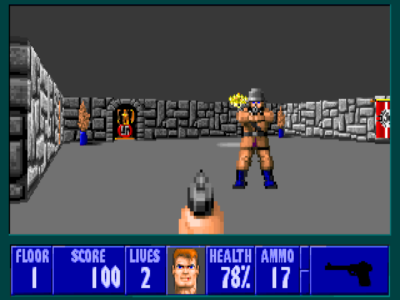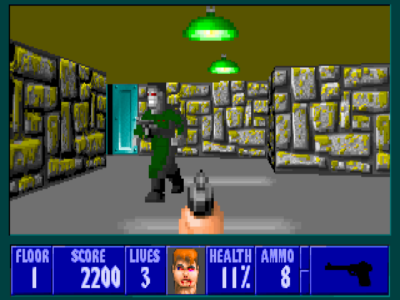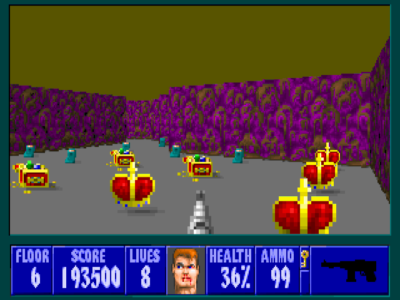
Wolfenstein 3D
Written by: Stoo
Date posted: August 10, 2007
- Genre: Action
- Developed by: id Software
- Published by: Apogee
- Year released: 1992
- Our score: 4
This is one of those oldies which, despite its historical significance, in six years of running this site we never quite got around to reviewing. Not that we have anything in particular against the game, it just wasn’t all that high up the priority list. Mostly because it’s not like we have a lot to say, or any new and stunning revelations. It’s not a “deep” game where we can talk about the sense of immersion, or the story, or the way it can suck away hours of your life. Also though it’s not an obscure title we feel was unfairly ignored. And we’re not really equipped to do a lengthy humorous deconstruction full of anecdotes about our childhoods and witty observations of gaming culture. Finally, er, we’re a bit lazy.
Recently however iD released most of their back catalogue on Steam, Valve’s online distribution service. Apart from a few obscure titles, almost all their works are there from Commander Keen to Doom 3. On top of that you can find a host of expansions, and also a few of the iD-engine-powered games from Raven like Hexen. Even better, they went and made the whole lot available in a single bundle that will set you back about £40. In truth some of that isn’t all that interesting to me; I’m not into multiplayer shooters so that rules out Quake 3. Also I’m really not sure I can be bothered to slog through 3rd-party mission packs for Doom and Quake. Still it works out as good value overall. It’s good to finally own a legit copy of some of these oldies and after five years I can return Rik’s copy of Hexen 2.
Most of that pack is valid material for this site, and we may as well start at the beginning. After all, there is that historical significance to speak of. Today we’re all familiar with the first-person shooter (FPS) – an action game that renders a 3-dimensional world from the perspective of the player character, usually with a lot of interior environments,and usually based around guns and ranged weaponry. Well, this is where the genre as we know it was established.
First a bit of perspective. Throughout the 80s there was a gradual progression of technology that produced first-person 3D on your screen, or at least approximations to it. Some early engines produced internal corridors based on tiles, with motion from one step to another and turns in 90 degrees – this would prove especially popular for dungeon-crawler RPGs. Others went for more true 3D, but of a very simple sort – a starfield with polygon spaceships, or flat landscapes with simple hills and tanks. By the late 80s technology like the Freescape engine allowed for outdoor environments based on polygons, that looked half-convincing and allowed for reasonable freedom of motion. Similar tech would be used to power simulators like LHX. None of this was quite doing what we”d understand as the first person shooters genre today, tho.

The guys in brown uniforms are fairly weak.
When iD software came along though, they developed a trick known as Raycasting. I’m no expert in programming, but as I understand it the technology works by starting with a floor plan and drawing up a bunch of vertical lines to create walls, scaled according to their distance from the “camera”. This allowed smooth scrolling, indoor environments. The first game to use it was the little-known Hovertank 3D. It was followed by Catacomb 3D – and crucially, this brought in another major advance in the form of wall textures. No longer restricted to being featureless planes, walls could be given the appearance of say stone or concrete by repeatedly mapping an image to them. Now, Catacomb 3D was restricted to the 16-colour palette of EGA graphics. Later that year however the same engine, now applying the shiny 256-colours of VGA, was used to power Wolfenstein 3D. The rest, as they say, is history. It wasn’t technically the very first first-person shooter, but it is now generally regarded as the first major landmark in the development of the genre. It”s the one that gamers really sat up and took notice of.
Looking back a decade and a half later, Wolf 3D seems almost laughably basic. Of course we’re not actually going to point and laugh because, well, that wouldn’t really suit our retro-gaming nature here. Rather, it’s interesting to note exactly how the game handled, as opposed to a modern shooter. The raycasting trick is after all really just cheating, not proper 3D at all as we would understand it today. You’ll notice here that the levels are all completely flat, and all the ceilings are at the same height. There’s no vertical variation in the geometry, and no concept of vertical motion.
There are further limitations: for one thing the walls are all at 90 degrees to each other, as if drawn on a giant grid. The maps rarely look like they might have some kind of real-world purpose, just random rooms and corridors, although they do at least have decorations like pillars, flags and tables. Ceilings and floors aren’t textured, leaving a grey or blue expanse dotted only with the occasional light fittings. Which don’t actually do anything; lighting levels are completely uniform. Finally enemies are drawn using flat sprites instead of any 3D geometry – the engine works out what angle a soldier is pointing our relative to you, and picks sprites from a list: “facing towards you, side on, at an angle” etc.
Still though, we have to stress Wolfenstein 3D was big news at the time. Until hardware could progress to the point where true 3D was viable for more than spartan flat planes and polygons, tricks like raycasting filled the gap for creating interior locations. It produced something that could run at a decent speed on the hardware of 1992, and looked near enough to 3D for the gamers of that time.

What’s worse than zombies? NAZI zombies! Only square-jawed Americans can save us now.
So anyway that’s a layman’s guide to tech stuff. The gaming experience meanwhile is all about shooting Nazis. Yup, always handy when you need completely black-and-white straightforward evil to fight. The setting is a highly fanciful version of world war 2 where you take on the role of BJ Blaskowitz, an American agent. The game is split into six chapters, each of about eight levels. The first chapter is all about BJ’s escape from castle Wolfenstein itself – which basically means wading through 8 levels shooting Nazis and finding keys until you finally reach the exit. It was given away freely under the shareware model, a tactic used for most games published by Apogee and a great means of drumming up publicity.
Most of the enemies you first encounter are various chunky-looking pixelated soldiers. You have only four weapons to fight them with, a practically useless knife and three guns that differ just in their rate of fire. In later chapters though things start to get a bit weird – zombies and vampire-looking things that shoot fireballs. At the end of chapter 3 you fight Hitler in a robot-suit. No, really. He has miniguns. Oddly the second three chapters are supposed to be prequels to the first three, although the word “prequel” kind of suggests there’s some kind of narrative going on. Which there isn’t, this really is just shooting Nazis (and Nazi zombies) until you reach the end-of-level elevator.
This review is mostly turning out to be a historical retrospective, but we do like to talk about the actual experience of playing a game. Now I think it”s important to say, some oldies like UFO or Monkey Island we believe have strengths still shine through today. That’s our reason for covering early-90s titles in the first place – we believe that, given a tolerance for dated graphics, some of them score achievements that aren’t yet completely overshadowed by modern games. With this in mind, I hope it doesn’t seem completely redundant to say that this particular oldie has however been thoroughly bettered in every regard. There’s no aspect in which it still does as well as its modern peers. The genre has come along a *long* way, and not just the graphics. AI, physics, and storytelling have improved by vast amounts.

Nazi treasure vaults consist of crowns and chests of gold spaced very evenly on the floor.
What does that leave? Good old nostalgia of course – something we don’t claim to be entirely immune to. There’s the bright colourful VGA corridors. The muffled digitized shouts in German, the FM synthesizer music. Running up and down every single wall holding down the space-bar looking for secret doors. An old-skool points score to rack up, by seeking out hidden treasure. Also, the cheerfully incongruous Commander-Keen-esque jingle that plays when you pick up golden loot. You’re bound to get some spark of reminiscence over what was so fun all those years ago. For about 20 minutes anyway, before reality reminds you you’re running around samey-looking abstract corridors with no real aim beyond picking up a key or finding an exit.
From here, id would go on to dominate the genre. They would release a landmark game, others would follow in their wake with copycats of varying success, then they’d raise the bar again with their next title. Eventually their basic run-and-gun kind of single-player action would be bettered by more involving and imaginative games like Half-life, but they’re still one of the top engine developers. So I think that any serious gamer should take half an hour to play the (legally free!) shareware episode – if only to see where it all came from. You’ve got to be a pretty hardcore retro-gamer to stick with it for any longer, but that brief reminder is worthwhile to give yourself some perspective on just how far we’ve come in 15 years.


 Posts
Posts